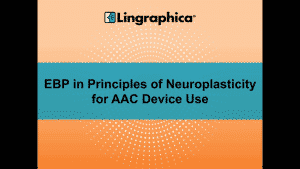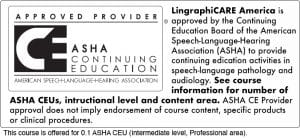 In our course on Evidence-Based Practice, Speech Language Pathologists (SLPs) will learn about the research behind the 10 principles of neuroplasticity. We’ll explore key aspects, including:
In our course on Evidence-Based Practice, Speech Language Pathologists (SLPs) will learn about the research behind the 10 principles of neuroplasticity. We’ll explore key aspects, including:
-
- identifying the principles of neuroplasticity
- describing three research-based techniques for incorporating the principles in rehabilitative treatment
- incorporating principles of neuroplasticity into evidence-based practice for AAC device use
Lingraphica’s course “EBP in Principles of Neuroplasticity for AAC Device Use” provides an overview of the ten principles of neuroplasticity. It then demonstrates how these principles provide an approach that allows SLPs and communication partners to overcome communication challenges during device training.
In this course, we will focus on ways in which the principles of neuroplasticity can be applied to rehabilitative work. We will explore research that supports this approach, with a focus on how it applies to AAC device training and communication partner support. Research shows that some of the benefits to communication partner training in AAC include increased functional communication (salience), increased motivation, and improved overall outcomes. We will also discuss the importance of leveraging the 10 principles of neuroplasticity with a specific focus on the benefits to the communication partner as well as overall success with AAC device use.
We will also discuss device customization and its importance in leveraging the principle of salience, particularly as it relates to the Life Participation Approach to Aphasia (LPAA). LPAA puts the goals and interests of the patient at the center of treatment. This includes documenting success based on how a patient is able to re-engage with society.

To demonstrate how this all comes together, we will provide a device demonstration, pulling from all of the elements we have reviewed so far in the course. We will address each of neuroplasticity’s ten principles, and connect each one to personalizing, customizing, and using high-tech AAC. We will explore various AAC topics of choice for adult AAC device users, with a focus on topics outside of basic needs or health issues. These include family, travel, hobbies, and religion. We will explore why customization is so important, and how it ultimately supports patients in their overall communication goals.
EBP in Principles of Neuroplasticity for AAC Device Use
To learn more about evidence-based practice and AAC devices, watch our free CE course,
“EBP in Principles of Neuroplasticity for AAC Device Use”.




